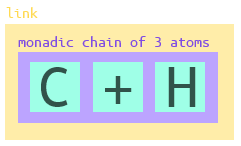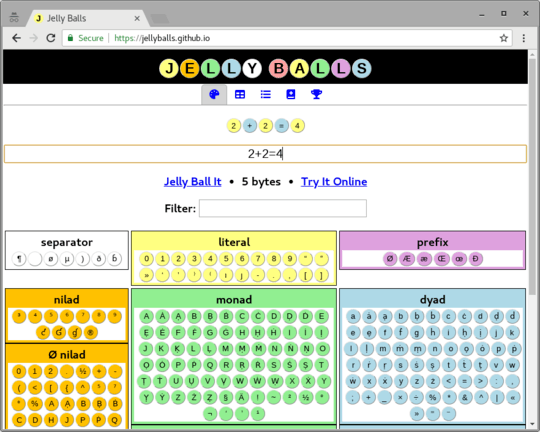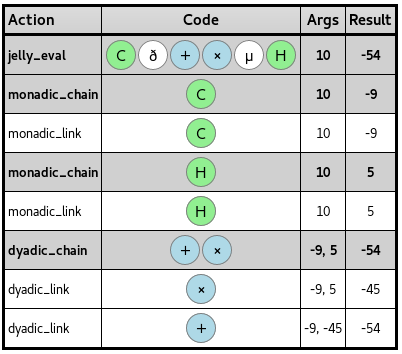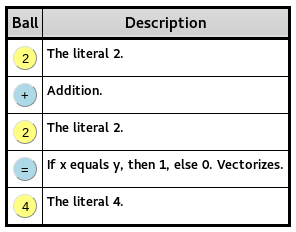List commands and literals
If you attempt to use many of the non-vectorizing list commands on a literal n or a list of literals z, the list command will first convert to a list of some sort and then carry out the command on that list.
These commands appear use calls to the iterable function in jelly.py.
def iterable(argument, make_copy = False, make_digits = False, make_range = False):
the_type = type(argument)
if the_type == list:
return copy.deepcopy(argument) if make_copy else argument
if the_type != str and make_digits:
return to_base(argument, 10)
if the_type != str and make_range:
return list(range(1, int(argument) + 1))
return [argument]
Here are some incomplete lists of what those list commands will do.
Wraps in a list
The simplest return from iterable to wrap the argument in a list, and return that to be processed by the function. This happens if the argument is not already a list, is a string, and iterable's arguments don't call for other methods.
-------------------------------------------------------------------------------
| Command | Description | Process | Effect |
-------------------------------------------------------------------------------
| F | Flattens a list | 4953F -> [4953]F -> [4953] | Same as W |
-------------------------------------------------------------------------------
| G | Format a list | 4953G -> [4953]G -> [4953] | Same as W |
| | as a grid | | |
-------------------------------------------------------------------------------
| I | Increments | 4953I -> [4953]I -> <nothing> | Empty list |
-------------------------------------------------------------------------------
| S | Sums a list | 4953S -> [4953]S -> 4953 | Same as ¹ |
-------------------------------------------------------------------------------
| Ṭ | Boolean array, | 4Ṭ -> [4]Ṭ -> [0, 0, 0, 1] | n-1 zeroes, |
| | 1s at indices | | 1 at end |
-------------------------------------------------------------------------------
| Ụ | Sort indices by | 4Ụ -> [4]Ụ -> [1] | Yields [1] |
| | by their values | | |
-------------------------------------------------------------------------------
| Ė | Enumerate list | 4Ė -> [4]Ė -> [[1, 4]] | Yields [[1, n]] |
-------------------------------------------------------------------------------
| Ġ | Group indices | 4Ġ -> [4]Ġ -> [[1]] | Yields [[1]] |
| | by values | | |
-------------------------------------------------------------------------------
| Œr | Run-length | 4Œr -> [4]Œr -> [[4, 1]] | Yields [[n, 1]] |
| | encode a list | | |
-------------------------------------------------------------------------------
Convert to base 10
The functions here call iterable to converts to a number to a list of its digits D, and then run on those digits.
-------------------------------------------------------------------------
| Command | Description | Process | Effect |
-------------------------------------------------------------------------
| Q | Unique elements | 299Q -> [2, 9, 9]Q -> [2, 9] | Unique |
| | ordered by | | digits |
| | appearance | | of n |
-------------------------------------------------------------------------
| Ṛ | Non-vectorized | 4953Ṣ -> [4, 9, 5, 3]Ṛ | Reverses D |
| | reverse | -> [3, 5, 4, 9] | |
-------------------------------------------------------------------------
| Ṣ | Sort a list | 4953Ṣ -> [4, 9, 5, 3]Ṣ | Sorts D |
| | | -> [3, 4, 5, 9] | |
-------------------------------------------------------------------------
Convert to list with range
The functions here convert a number to the range R = [1 ... n], and then run on that range.
-----------------------------------------------------------------------------------------
| Command | Description | Process | Effect |
-----------------------------------------------------------------------------------------
| X | Random element | 4R -> [1 ... 4]X -> 2 | Random element |
| | | | of R |
| | | | |
-----------------------------------------------------------------------------------------
| Ḋ | Dequeue from list | 4R -> [1 ... 4]Ḋ -> [2, 3, 4] | Range [2 ... n] |
-----------------------------------------------------------------------------------------
| Ṗ | Pop from list | 4Ṗ -> [1 ... 4]Ṗ -> [1, 2, 3] | Range [1 ... n-1] |
-----------------------------------------------------------------------------------------
| Ẇ | Sublists of list | 4Ẇ -> [1 ... 4]Ẇ | All sublists of R |
| | | -> [[1], [2], [3], [4], [1, 2], | |
| | | [2, 3], [3, 4], [1, 2, 3], | |
| | | [2, 3, 4], [1, 2, 3, 4]] | |
-----------------------------------------------------------------------------------------
| Ẋ | Shuffle list | 4Ẋ -> [1 ... 4]Ẋ -> [2, 1, 3, 4] | Shuffles R |
-----------------------------------------------------------------------------------------
| Œ! | All permutations | 3Œ! -> [1, 2, 3]Œ! | All permutations |
| | of a list | -> [[1, 2, 3], [1, 3, 2], | of R |
| | | [2, 1, 3], [2, 3, 1], | |
| | | [3, 1, 2], [3, 2, 1]] | |
-----------------------------------------------------------------------------------------
| ŒḄ | Non-vectorized | 4ŒḄ -> [1 ... 4]ŒḄ | Bounces R |
| | bounce, | -> [1, 2, 3, 4, 3, 2, 1] | |
| | z[:-1] + z[::-1] | | |
-----------------------------------------------------------------------------------------
| Œc | Unordered pairs | 4Œc -> [1 ... 4]Œc | Unordered pairs |
| | of a list | -> [[1, 2], [1, 3], [1, 4], [2, 3], | of R |
| | | [2, 4], [3, 4]] | |
-----------------------------------------------------------------------------------------
| Œċ | Unordered pairs | 4Œċ -> [1 ... 4]Œċ | Unordered pairs |
| | with replacement | -> [[1, 1], [1, 2], [1, 3], [1, 4], | with replacement |
| | of a list | [2, 2], [2, 3], [2, 4], [3, 3], | of R |
| | | [3, 4], [4, 4]] | |
-----------------------------------------------------------------------------------------
| ŒP | Powerset of | 3ŒP -> [1 ... 3] | Powerset of R |
| | a list | -> ['', [1], [2], [3], [1, 2], | |
| | | [1, 3], [2, 3], [1, 2, 3]] | |
-----------------------------------------------------------------------------------------
| Œp | Cartesian | 4,2Œp -> [[1 ... 4], [1 ... 2]]Œp | Cartesian product |
| | product of z's | -> [[1, 1], [1, 2], [2, 1], [2, 2], | of [1 ... z[i]] |
| | items | [3, 1], [3, 2], [4, 1], [4, 2]] | for i in z |
-----------------------------------------------------------------------------------------







13Makes me wonder if Jelly is still too much in flux for this to generate content that will be useful in the long run, but the best person to answer that is probably Dennis. – Martin Ender – 2016-02-03T13:30:29.070
2I think there are already plenty of tips that should make sense no matter what changes happen in the language. Tips for golfing in Pyth has the same problem, I suppose, but it has passed the test of time reasonably well so far; answers are usually updated whenever they no longer apply because of a language change, albeit with some delay. – Lynn – 2016-02-03T13:32:45.547
3Here's a nice tip: become @Dennis's apprentice. Then, you will really be good at golfing jelly. – Conor O'Brien – 2016-02-03T19:41:31.050
12@Lynn I love how you say our very own Dennis. It's like we're all one big family :D. – None – 2016-03-19T17:11:26.923
This thread in Jelly's GitHub issues on how to actually type Jelly code page characters is probably worth a tip or two: https://github.com/DennisMitchell/jelly/issues/6 I don't have access to a Windows machine, though, so I don't feel confident writing up those bits.
– Jordan – 2017-11-02T15:47:04.327